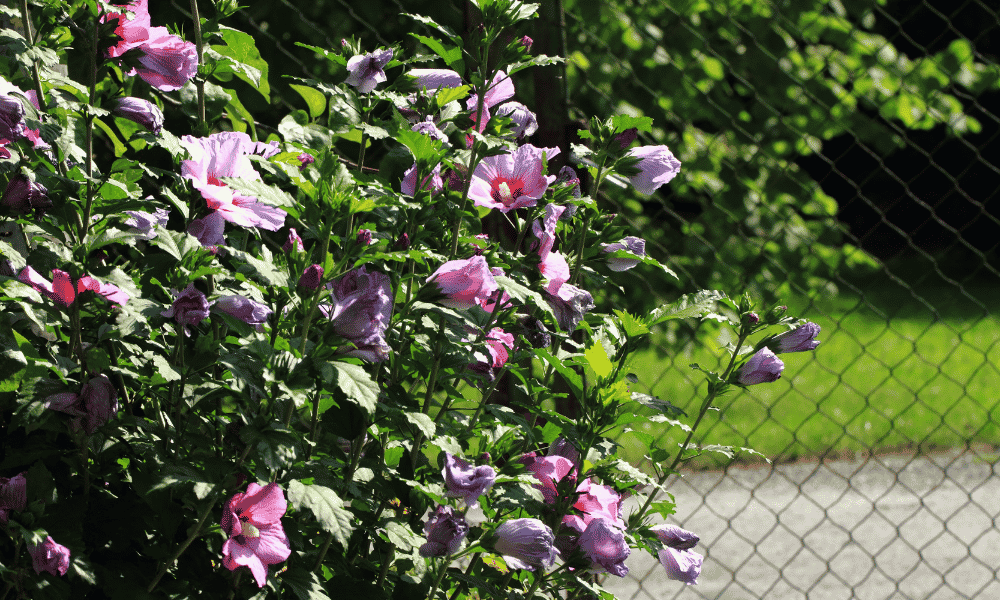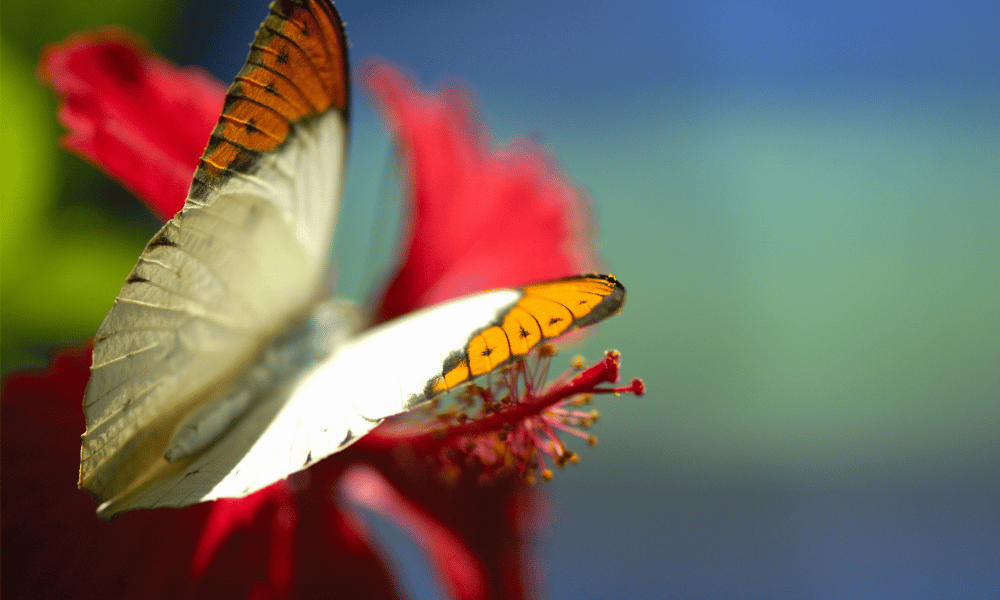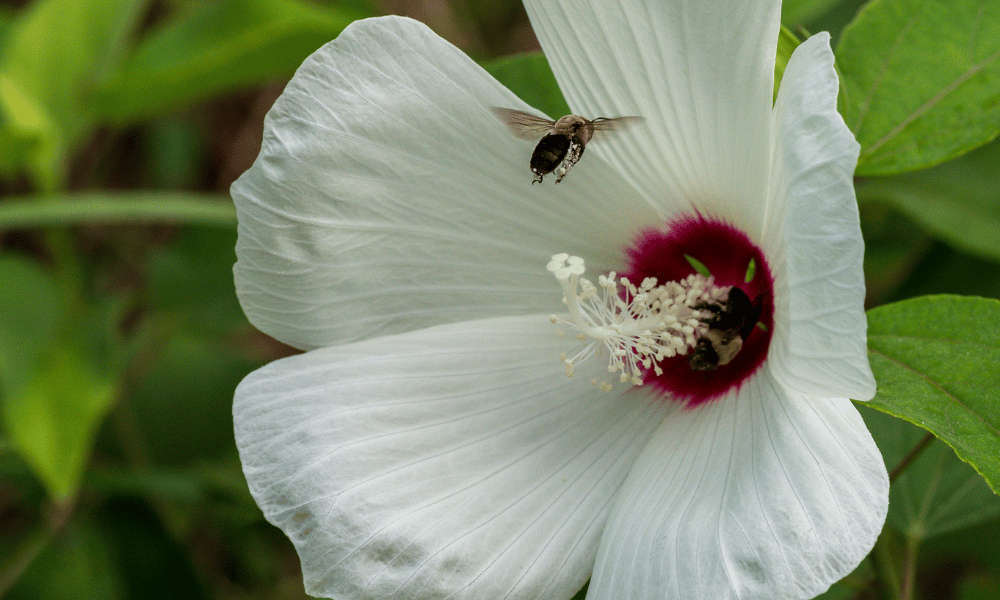Bold and unique, hibiscus flowers add a new level of beauty to your garden. These colourful and bright blooms attract a range of pollinators with their large trumpet-style shaped petals. But, are butterflies attracted to hibiscus too?
Yes, butterflies are attracted to hibiscus. Hibiscus is loaded with easy-to-access nectar which is exactly what a butterfly needs.
The size of hibiscus flowers makes it easy for butterflies to enjoy the nectar of the flower. Hibiscus flowers grow on a variety of shrubs, bushes, and even trees allowing you to really diversify your landscape with these tropical additions.

What Else Does Hibiscus Attract?
In addition to butterflies, hibiscus flowers also attract honeybees, hummingbirds and other pollinating insects. Bright and bold blooms stand out amongst other foliage and the size and shape of the flower make it easy for insects to access the nectar and pollen of the flower.
As bees, butterflies, hummingbirds, and other pollinating insects eat from the hibiscus flower, they collect pollen on their legs and bodies. Pollen is located on the stamen of the hibiscus flower. These are long pin-like structures.
The pollinating insect grazes the pollen as it flies by and the pollen then is transferred to the female part of the flower called the pistil. Once the pollen has entered the pistil, it travels down and creates either a fruit or a seed. In the case of the hibiscus plant, a seed is created.
Which Varieties of Hibiscus Attract Butterflies?
With so many options of hibiscus growing plants at your local nursery, you may be wondering which ones attract butterflies. Butterflies can see a wide range of colours including UV light. This means that certain colours will be more appealing to them than others.
Butterflies can see blue, red, green, violet, and UV light thanks to their unique eyesight.
Butterflies are attracted to bright-coloured flowers, so choosing a hibiscus plant that yields large and impressive blooms is a great start. Bright pink, orange, violet, and blue hibiscus flowers will all attract bountiful butterflies.
These flowers also elevate your garden space to attract more pollinators like bees and hummingbirds.
Bees cannot see the colour red, because they lack a certain cone inside their eye to see this colour’s length. To bees, red is essentially black or the absence of colour.
If you also want to appeal to honeybees or bumble bees, avoid planting red hibiscus flowers and instead choose a purple, blue, or yellow hibiscus bloom. Catering to all the pollinators is important to help keep species alive and thriving.
Yes, generally all hibiscus plants that are not hybrids will attract butterflies as they are all loaded up with nectar that is easy for a butterfly to access.
Yes! Any plant that has a reliable source of nectar that is easy to access will draw in bees. Hibiscus has open flowers which are full of nectar which is exactly what bees love.
Why Do Butterflies Like Hibiscus?
Butterflies like hibiscus plants because they are full of delicious and nutritious nectar. The large flat face of the flower makes it easy for the butterfly to access the pistil where the nectar is stored.
This open-face style bloom is also ideal for hummingbirds to access with their long beaks too. It is also why bees love hibiscus flowers.
What Other Plants Do Butterflies Like?
Creating the ideal oasis for butterflies requires a few different things. The first is a great food source for both adult butterflies and caterpillars. Asters in all shades of colours make a great addition to your garden space as both caterpillars and adult butterflies enjoy them.
For Monarch caterpillars, milkweed is the only way to go. These butterflies are sometimes called milkweed butterflies because Monarch caterpillars will only eat milkweed. If you are hoping to see some bright orange butterflies fluttering around your garden, be sure to plant some milkweed.
Drinking water is important for butterflies as well. A shallow bird bath allows thirsty butterflies to have a drink. A bee bubbler is also a great way to ensure that all the pollinators are getting enough hydration.
Add marbles to a shallow dish and fill with just enough water that the insects can drink while safely sitting on the marbles. Bees cannot swim and will drown, so this allows them to enjoy a sip of water without the danger of an open birdbath.
Want to Attract Butterflies to Your Garden?
We’ve Put Together an Ultimate Guide to Attracting Butterflies to Your Garden Including Our Top 11 Plants You NEED to Start Growing Today:
Summary
Hibiscus flowers are bold, bright, and beautiful. They come on shrubs, bushes, and even trees that can grow every year providing your garden with a unique tropical vibe.
These large trumpet-shaped blooms attract butterflies, hummingbirds and bees thanks to their bright colours and bountiful nectar.
Choosing which hibiscus plant is right for your garden is very simple. Butterflies can see almost every colour and are attracted to bright reds, yellows, oranges, blues, violets, and white. You cannot go wrong when it comes to picking a colour for butterflies!
If you also want to attract bees, stick to yellows, blues, and violets as these are the colours that bees see the best.
Be sure to plant other plants that help butterflies thrive if you want to create a butterfly oasis in your garden. Milkweed, dill, and asters provide food for both adult butterflies as well as caterpillars. Adding a bee bubbler allows butterflies and bees to stay hydrated during those long hours of pollination.









Will the three seedless varieties of Hibiscus (or Rose of Sharon) known as Azure Blue Satin (DVPazurri), Orchid Satin (ILVO347), and Purple Satin (ILVOPS) provide nectar for butterflies, hummingbirds, and bees?
I like the idea of seedless Hibiscus to keep them from taking over the garden, but if they don’t feed the pollinators I won’t plant only them, but a combination of them with the self seeding variety.
Thank you in advance for your reply.